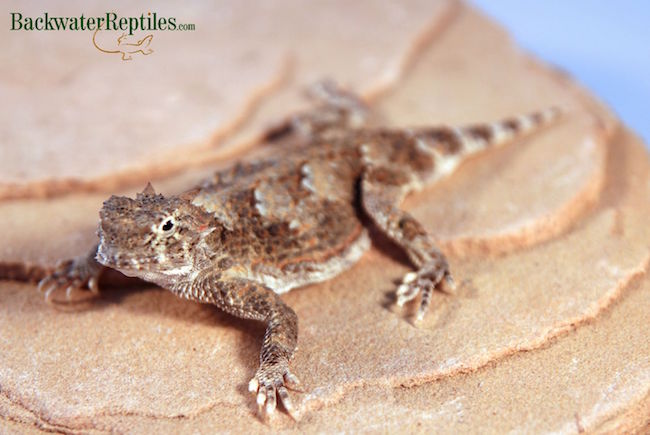Here are a few facts about Desert Horned lizards–probably the most unique-looking lizards in the country. The Desert Horned Lizard (Phrynosoma platyrhinos) is also known as the Horny Toad lizard or the Short-horned lizard and is native to desert terrains. These interesting-looking lizards are short, round, flat, and as their name suggests, horned. They have an array of spikey scales on their bellies and heads which make them appear quite fierce, although as pets they are pretty laid-back.

Horned lizards can be tough to keep in captivity due to the fact that their main diet in the wild consists of ants, which are not necessarily easy to come by in the pet food trade. Horned lizards can and will eat other normal feeder insects such as crickets, but they need ants in their diet in order to thrive, so we recommend making sure you can acquire ants or live near an ant hill before you commit to a horned lizard as a pet.
The primary reason ants are an important part of their diet is because ants contain formic acid. Fortunately, there is a product produced by Repashy called Formic-Cal Plus, which is a supplement powder you can dust feeder insects with (such as crickets), so that the horned lizards are getting proper amounts of formic acid.
Certain horned lizards, such as the Phrynosoma asio (Giant Mexican Horned lizard) can be fed crickets and other insects exclusively.

The most bizarre thing about these amazing lizards is their primary defense mechanism against predators. Not only can they puff themselves up and make themselves hard to swallow, but they can squirt blood out of the corners of their eyes with fairly decent accuracy! It’s assumed that they aim for predators’ eyes and only use this tactic as a last resort.

These flat little lizards are excellent burrowers and camouflagers. They like to remain very still and blend in with their surroundings or submerge themselves in desert sand to hide out from potential threats. In captivity, this means you should provide them with a substrate that accommodates their burrowing, such as a compacted sand and soil mix, as well as provide plenty of hide spaces. Remember, substrate that is too dry will not properly hold a burrow.
Backwater Reptiles regularly offers Horned Lizards for sale. They are not necessarily the best pet reptiles for beginners due to their somewhat specialized diet, but experienced herp hobbyists should have no trouble keeping these squat little critters happy.

